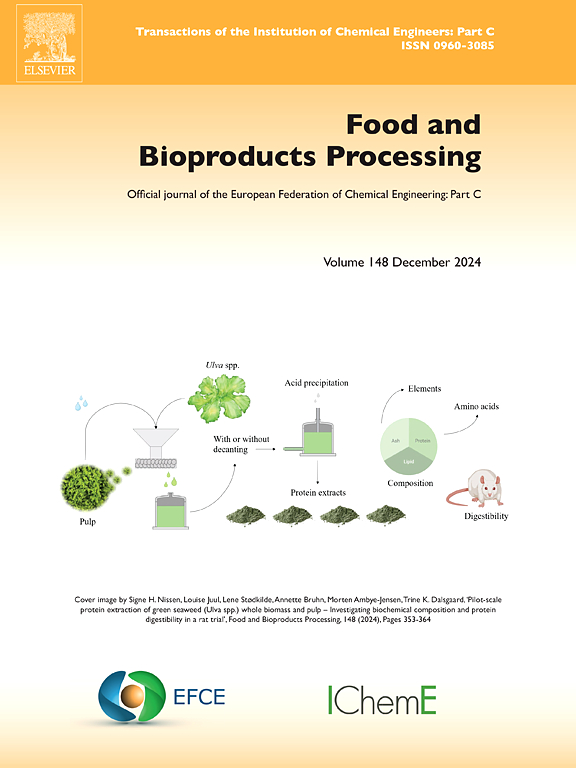Effect of infrared power and intermittency ratio on combined infrared-convective intermittent drying of banana
IF 3.4
2区 农林科学
Q2 BIOTECHNOLOGY & APPLIED MICROBIOLOGY
引用次数: 0
Abstract
This work compared continuous and intermittent combined infrared-convective drying of banana using the response methodology surface by desirability function approach. The effectiveness of the drying process concerning the energy performance, CO2 emission, and the resistance to moisture transfer were reported and discussed. Experiments were performed according to a 3² factorial design taking infrared power (P) (118, 178, and 238 W) and the intermittency ratio (α) (0, 0.333, and 0.667) as independent factors. It was found a reduction in the drying time by 79 % (for α = 0.333) and 74 % (for α = 0.667) when the IR power increased from 118 W to 238 W. Optimal operating condition was obtained for P = 216 W and α = 0.289 which a 'very good' global desirability was achieved, corresponding to a final moisture content of 12.19 % (w.b.), 17.80 kWh/kgH2O SEC, and 8.89 gCO2,eq. The effective moisture diffusivity ranged from 2.88 × 10−9 to 2.41 × 10−8 m2/s. The resistance by diffusion was greater than the vapor convective one. The conventional drying gave resistance to diffusion of about 1.33 times higher than the intermittent drying with α = 0.333. The net energy for intermittent drying was higher which reinforces its superiority in terms of an energy-effective process.
红外功率和间歇比对香蕉红外-对流联合间歇干燥的影响
利用期望函数法的响应方法学面对香蕉连续和间歇联合红外对流干燥进行了比较。报告并讨论了干燥过程在能源性能、二氧化碳排放和抗水分传递方面的有效性。实验采用3²因子设计,分别以红外功率(P)(118、178、238 W)和间歇比(α)(0、0.333、0.667)为独立因子。当红外功率从118 W增加到238 W时,干燥时间分别缩短了79 % (α = 0.333)和74 % (α = 0.667)。获得了P = 216 W和α = 0.289的最佳操作条件,达到了“非常好的”整体理想,对应于最终水分含量为12.19 % (w.b.), 17.80 kWh/kgH2O SEC和8.89 gCO2,等。有效水分扩散系数范围为2.88 × 10−9 ~ 2.41 × 10−8 m2/s。扩散阻力大于蒸汽对流阻力。常规干燥的抗扩散能力是间歇干燥的1.33倍,α = 0.333。间歇干燥的净能量较高,这加强了它在节能过程方面的优势。
本文章由计算机程序翻译,如有差异,请以英文原文为准。
求助全文
约1分钟内获得全文
求助全文
来源期刊

Food and Bioproducts Processing
工程技术-工程:化工
CiteScore
9.70
自引率
4.30%
发文量
115
审稿时长
24 days
期刊介绍:
Official Journal of the European Federation of Chemical Engineering:
Part C
FBP aims to be the principal international journal for publication of high quality, original papers in the branches of engineering and science dedicated to the safe processing of biological products. It is the only journal to exploit the synergy between biotechnology, bioprocessing and food engineering.
Papers showing how research results can be used in engineering design, and accounts of experimental or theoretical research work bringing new perspectives to established principles, highlighting unsolved problems or indicating directions for future research, are particularly welcome. Contributions that deal with new developments in equipment or processes and that can be given quantitative expression are encouraged. The journal is especially interested in papers that extend the boundaries of food and bioproducts processing.
The journal has a strong emphasis on the interface between engineering and food or bioproducts. Papers that are not likely to be published are those:
• Primarily concerned with food formulation
• That use experimental design techniques to obtain response surfaces but gain little insight from them
• That are empirical and ignore established mechanistic models, e.g., empirical drying curves
• That are primarily concerned about sensory evaluation and colour
• Concern the extraction, encapsulation and/or antioxidant activity of a specific biological material without providing insight that could be applied to a similar but different material,
• Containing only chemical analyses of biological materials.
 求助内容:
求助内容: 应助结果提醒方式:
应助结果提醒方式:


